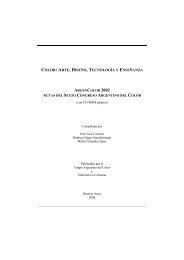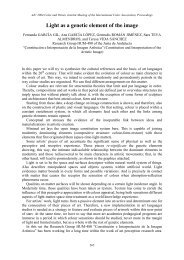The rhetoric of black, white and red
The rhetoric of black, white and red
The rhetoric of black, white and red
Create successful ePaper yourself
Turn your PDF publications into a flip-book with our unique Google optimized e-Paper software.
ProceedingsAIC 2003 BangkokColor Communication <strong>and</strong>ManagementGr<strong>and</strong> Hyatt Erawan HotelBangkok, Thail<strong>and</strong>4-6 August 2003Aran HansuebsaiEditorOrganized byChulalongkorn University<strong>The</strong> Color Group <strong>of</strong> Thail<strong>and</strong>Supported by<strong>The</strong> Federation <strong>of</strong> Thai IndustriesThai Airways InternationalTourism Authority <strong>of</strong> Thail<strong>and</strong>
<strong>The</strong> papers appearing in this book compose the proceedings <strong>of</strong> the technical conference cited on the cover <strong>and</strong> titlepage <strong>of</strong> this volume. <strong>The</strong>y reflect the authors’ opinions <strong>and</strong> are published as presented, in the interests <strong>of</strong> timelydissemination. <strong>The</strong>ir inclusion in this publication does not necessarily constitute endorsement by the editor. Paperswere selected by the conference program committee to be presented in oral or poster format, <strong>and</strong> were subject toreview by volume editors or program committees.Please use the following format to cite material from this book:Author(s), “Title <strong>of</strong> paper,” in Proceedings <strong>of</strong> AIC 2003 Bangkok: Color Communication <strong>and</strong>Management, page numbers (2003).ISBN 974-13-2516-9Published by<strong>The</strong> Color Group <strong>of</strong> Thail<strong>and</strong> (CGT)58 Napasap 5, Sukhumvit 36, Klongton, Klongtoey, Bangkok 10110, Thail<strong>and</strong>Tel: 66-2-2185588-9 Fax: 66-2-218-5583http://www.colorgroupthai.comCopyright© 2003, <strong>The</strong> Color Group <strong>of</strong> Thail<strong>and</strong>.Printed by DocuTech6135 <strong>and</strong> Docucolor6060Thai Fuji Xerox Co., Ltd.Bangkok, Thail<strong>and</strong>THE DOCUMENT COMPANYFUJI XEROX
<strong>The</strong> <strong>rhetoric</strong> <strong>of</strong> <strong>black</strong>, <strong>white</strong> <strong>and</strong> <strong>red</strong>:Reasonability <strong>and</strong> aesthetics to persuade with colorJosé Luis Caivano <strong>and</strong> Mabel A. LópezNational Council for Research, <strong>and</strong> Buenos Aires University, ArgentinaBLACK, WHITE, AND RED IN CULTUREWhy <strong>black</strong>, <strong>white</strong>, <strong>and</strong> <strong>red</strong>? Our proposal is to analyze how the use <strong>of</strong> color can be a privileged element to arguein a visual image. <strong>The</strong> values <strong>and</strong> connotations ascribed to color in the context <strong>of</strong> a visual statement work as“pro<strong>of</strong>s” in reasoning <strong>of</strong> the persuasive type. In this way, the use <strong>of</strong> <strong>rhetoric</strong>al figures is not an end in itself, butthe visible correlate <strong>of</strong> the argumentation that works as a hidden, implicit structure <strong>of</strong> persuasion. We havechosen <strong>black</strong>, <strong>white</strong>, <strong>and</strong> <strong>red</strong> because <strong>of</strong> their high frequency in appearing, the great number <strong>of</strong> uses, <strong>and</strong> theabundance <strong>of</strong> socio-cultural interpretations —which even may be apparently paradoxical or contradictory. Allthese senses are latent, <strong>and</strong> coexist. Colors are reinterpreted in correspondence with the contexts <strong>of</strong> use in thetexts themselves (co-text), <strong>and</strong> with the effective social contexts, which frame them in a real situation(historical space <strong>and</strong> time).Phylogenetic argument: Before the instauration <strong>of</strong> language, the primitive man regarded <strong>red</strong> <strong>and</strong> <strong>black</strong> ascolors that disturbed his rest. Since life began to develop in the forest, man became p<strong>red</strong>ominantly visual; food<strong>and</strong> sex were linked to light. <strong>The</strong> <strong>black</strong> night <strong>and</strong> its <strong>red</strong> prelude, sunset, announced the proximity <strong>of</strong> danger.Lacking night vision, man was exposed to p<strong>red</strong>ators (stronger, with better sense <strong>of</strong> smell, <strong>and</strong> more acutehearing) when the forest turned into a <strong>black</strong> depth. <strong>The</strong> <strong>red</strong> glints <strong>of</strong> fire fascinated him in those long <strong>and</strong>worrying nights in which a real <strong>and</strong> tangible danger was around. We could imagine that ancestral feeling byremembering the fear that darkness produced us when we were children.Red <strong>and</strong> <strong>black</strong> were associated with the dangers that threatened the survival <strong>of</strong> the species. <strong>The</strong> <strong>black</strong> <strong>of</strong>night <strong>and</strong> the <strong>red</strong> <strong>of</strong> blood are alerting, warning colors. On the contrary, the <strong>white</strong> <strong>and</strong> light blue <strong>of</strong> day, thebrowns <strong>and</strong> greens <strong>of</strong> soil <strong>and</strong> foliage are reassuring colors.Man built shelters, enlightened the darkness, <strong>and</strong> dominated the natural <strong>and</strong> animal world; however, hisbrain has not forgotten. Today, to discriminate the color <strong>of</strong> danger is not a relevant information to save the life<strong>of</strong> the species; however, there are still tracks in the archaic memory <strong>of</strong> the brain that make us react againstthose stimuli (López Pasquali 1998).Feeling, thinking, naming: Berlin <strong>and</strong> Kay (1969) have investigated the basic color terms in various languagesacross the world. <strong>The</strong>y distinguish eleven basic color terms that appear in the most different cultures: <strong>white</strong>,<strong>black</strong>, <strong>red</strong>, green, yellow, blue, brown, purple, pink, orange, <strong>and</strong> gray. At the same time, they have elaborated atheory, according to which the evolution <strong>of</strong> the color names goes through seven stages. <strong>The</strong> first one (thecultures that only have two color terms) corresponds to “<strong>white</strong>” <strong>and</strong> “<strong>black</strong>”. Immediately, in the next stage, thethird category to emerge is “<strong>red</strong>”. It includes all <strong>red</strong>, orange, brown, pink, purple, <strong>and</strong> violet colors.It is evident that to communicate this perceptual chromatic sensation was decisive in the primitivecommunities, hence, <strong>red</strong> appears next to the achromatic colors, whose distinction was equivalent to the value(light-dark). With the third category, not only a color name appears but also a new cognitive dimension: thecategory <strong>of</strong> chromatic color. This third term, “<strong>red</strong>”, was equivalent to say “color”. 1Ritual <strong>and</strong> religious persuasion <strong>and</strong> intimidation: <strong>The</strong> color triad <strong>of</strong> <strong>black</strong>, <strong>white</strong>, <strong>and</strong> <strong>red</strong>, pointed out byanthropologists as basic colors, appears frequently in different forms <strong>of</strong> body decoration in “primitive” cultures(Hutchings 1989). <strong>The</strong>y are also the most <strong>of</strong>ten used colors in British <strong>and</strong> Irish folklore. <strong>The</strong>y serve todistinguish the central characters or actors <strong>of</strong> a ceremony or activity. In traditional tales, the <strong>black</strong>-<strong>white</strong>opposition is used to represent the antithesis between good <strong>and</strong> evil. Red symbolizes the blood <strong>of</strong> Christ, or isused to frighten (Hutchings 1993).1. In Spanish, “rojo” (<strong>red</strong>) is synonym <strong>of</strong> “colorado”: having color, colo<strong>red</strong>.Proceedings <strong>of</strong> AIC 2003 Bangkok: Color Communication <strong>and</strong> Management 341
In Japan, <strong>red</strong>, <strong>white</strong>, <strong>and</strong> yellow are colors <strong>of</strong> good luck, which does not happen in the Western culture. Inthe cultures surveyed by Hutchings (1997), achromatic colors are associated with mourning rites (death). <strong>The</strong>use <strong>of</strong> the <strong>black</strong>-<strong>white</strong>-<strong>red</strong> triad is frequent in diverse rituals to symbolize the passage from a status to another:birth, wedding, baptisms, funerals.In the East, <strong>red</strong> means authority, power, wealth, good luck, political ideologies; it is used to purge evil.Behind these ideas, there is a religious <strong>and</strong> philosophical background that is sha<strong>red</strong> by the Oriental world(Kwon 2002).In the West, a wristlet <strong>of</strong> coral has been used since ancient times as amulet to protect children from illness.This belief still remains in South America: a <strong>red</strong> stripe around the wrist <strong>of</strong> babies, or hidden inside theirclothes, is thought to reject the negative influences (evil, envy, illness) that they attract because <strong>of</strong> their fragility<strong>and</strong> beauty.In the Christian iconography, <strong>black</strong> <strong>and</strong> <strong>red</strong> symbolize the evil (hell, devil). However, <strong>red</strong> also acquirepositive values. It represents charity, because it is the blood shed by Christ to save the world. In the images <strong>of</strong>the Virgin, the blue color <strong>of</strong> her robe means virginity, <strong>and</strong> the <strong>red</strong> color, the virtue <strong>of</strong> charity.<strong>The</strong> power <strong>of</strong> alchemy was manifested by means <strong>of</strong> color, especially by <strong>red</strong>, <strong>white</strong>, <strong>and</strong> <strong>black</strong>. Figure 1 is thediagram by Reusner (a manuscript from c.1550) that shows the last but one phase <strong>of</strong> transmutation <strong>of</strong> basicmetals into gold. We can see the White Queen, a prelude <strong>of</strong> the arrival <strong>of</strong> the Red King. <strong>The</strong> half-circle at thebottom shows the alchemic progression from <strong>black</strong> to <strong>red</strong>, passing through <strong>white</strong>. Because <strong>of</strong> this influence,Baby Jesus has been represented holding a <strong>red</strong> rose.This chromatic triad had a place <strong>of</strong> privilege in heraldic. Norms were established with non-rigorous <strong>and</strong>even contradictory arguments. For instance, at the end <strong>of</strong> the 14th century, an English writer on heraldic,Johannes de Bado Aureo (John <strong>of</strong> the Golden Bucket), conside<strong>red</strong> that <strong>red</strong> was equidistant to <strong>black</strong> <strong>and</strong> <strong>white</strong>—though he did not explain why—, <strong>and</strong> was the most appropriate color for princes <strong>and</strong> knights, because itsymbolized courage. During the 19th century, a more psychological interpretation <strong>of</strong> the symbology <strong>of</strong> colorwas developed. <strong>The</strong> “synoptic table” by Humbert de Superville, published in 1827, characterized <strong>red</strong> as violent<strong>and</strong> expansive; <strong>white</strong> as being the state <strong>of</strong> equilibrium, calm, <strong>and</strong> clarity; <strong>and</strong>, on the other side, <strong>black</strong> asmeaning convergence, concentration, <strong>and</strong> solemnity (Gage 1993: chapter 5).BLACK, WHITE, AND RED IN THE URBAN ENVIRONMENT:PERSUASION IN MASS COMMUNICATIONLiving in big urban conglomerates has lead to a modification <strong>of</strong> the material conditions <strong>of</strong> human existence.<strong>The</strong> helplessness in front <strong>of</strong> the danger, that was a characteristic <strong>of</strong> the species, the fear <strong>of</strong> night <strong>and</strong> <strong>of</strong> the ownblood, that could be taken by the wild animals, have undergone some metamorphoses, but have not totallydisappea<strong>red</strong>. Chromatic stimuli —mediated by culture— reproduce some <strong>of</strong> those primary feelings. Why? Whatfor? One could ask: what is man looking for by evoking the bitter ancestral fears? Those who proposepersuasive messages in the frame <strong>of</strong> mass culture, use this three-color combination in a <strong>rhetoric</strong> way, with theaim <strong>of</strong> convince, dissuade, or seduce the public.In the new communicative <strong>and</strong> virtual environments in which man evolves, the use <strong>of</strong> color tends to producean impact on the senses previously to any reflection on the message. This is a great advantage whencompetition <strong>and</strong> the ephemeral condition <strong>of</strong> communications are a constant. <strong>The</strong> <strong>rhetoric</strong> persuasion (in thiscase, by means <strong>of</strong> color) only is useful when there is more than one voice, precisely, in the communities whe<strong>red</strong>issent is possible <strong>and</strong> the multiplicity <strong>of</strong> opinions can develop. For this reason, the birth <strong>of</strong> <strong>rhetoric</strong> happenedin a democratic context (the ancient Greece), as a method to make an argument prevail.<strong>The</strong> ancient Rhetoric (Aristotle 350 B.C.) is the first work that exposes a method, a technique to persuade<strong>and</strong> obtain adhesion on the part <strong>of</strong> the public. This <strong>rhetoric</strong> way was to be pursued in five steps: inventio,dispositio, elocutio, memoria <strong>and</strong> actio. In order to argue for something or against something, or about theutility or inconvenience <strong>of</strong> a certain thing, it was necessary to find what to say (the appropriate arguments), <strong>and</strong>how to say those ideas. <strong>The</strong> aspect <strong>of</strong> <strong>rhetoric</strong> concerned with the figures <strong>of</strong> speech used to persuade (how tosay) is called elocutio. For a long time the analysis <strong>of</strong> tropes (figures) was extended <strong>and</strong> generalized to explainthe aesthetic (creative) uses <strong>of</strong> language, its poetic function. <strong>The</strong> deviations that appear in creative texts withregard to the ordinary use <strong>of</strong> the code correspond to a plentiful repertoire <strong>of</strong> <strong>rhetoric</strong>al figures that the studieson poetics were coining along the centuries.Of the five parts in which <strong>rhetoric</strong> is organized, only two will be developed in this paper: inventio <strong>and</strong>elocutio —conside<strong>red</strong> to be <strong>of</strong> central interest for visual persuasion. <strong>The</strong> person who enounces a visualdiscourse is giving a first step in inventio, looking for the chromatic arguments, i.e., proposing a pseudo-logicalreasoning in which color takes part in the premises <strong>and</strong> conveys a conclusion. In a later phase, in elocutio —how to say—, those uses <strong>of</strong> color hold a correspondence with the employment <strong>of</strong> tropes, or <strong>rhetoric</strong>al figures342Proceedings <strong>of</strong> AIC 2003 Bangkok: Color Communication <strong>and</strong> Management
generated by a particular, intentional, or transgressive use <strong>of</strong> color. Rhetorical figures portray a conceptual orformal deviation produced in a statement with the aim <strong>of</strong> bringing the receptor to a meaning that is beyond theliteral meaning.<strong>The</strong> statements generated by the <strong>rhetoric</strong> machine —beyond the real effect on the public, whose impact isdifficult to measure— intend to make the receptor reason. <strong>The</strong> persuasive message employs a logic that —differently from the scientific logic— is not based on truths, but on c<strong>red</strong>ible arguments, values, <strong>and</strong>presumptions accepted by the receptor. <strong>The</strong> field <strong>of</strong> the <strong>rhetoric</strong> technique is not the scientific knowledge, it isthe doxa, 2 the current opinion, what is reasonable without mediating a demonstration <strong>of</strong> universal validity.Precisely, the doxa is a body <strong>of</strong> debatable knowledge, closer to “common sense” than to truth or falsity in thelogical sense.<strong>The</strong> <strong>rhetoric</strong>al use <strong>of</strong> <strong>black</strong>, <strong>white</strong>, <strong>and</strong> <strong>red</strong> is based upon sha<strong>red</strong> premises that connect a social group. This“ideology” comes from beliefs about human perception, metonymic associations (blood, fire, night), as well asmetaphoric ones, related to cultural memory (mourning, war, purity, evil, hell, political emblems, nationalities,etc.). Some <strong>of</strong> the most frequent beliefs in the Western culture are: “Red excites vision, is alerting”; “Blood(<strong>red</strong>) is synonym <strong>of</strong> danger”; “Red is vital, passional”; “Red is joy”; “White is clean, aseptic”; “White ispurity”; “White is neutrality”; “Black is sinister”; “Black is disturbing, mysterious”; “Black producesdepression”. <strong>The</strong> paradoxical nature <strong>of</strong> these asseverations, that acquire positive values (life, euphoria) ornegative values (death, dysphoria) according to the context, is explicit.How to convinceOnce the most effective arguments have been selected to produce a greater c<strong>red</strong>ibility on the receptor we intendto convince, it is necessary to decide what kind <strong>of</strong> reasoning are we going to employ to persuade. <strong>The</strong>argumentative logic may adopt an inductive form (giving examples <strong>and</strong> models to be imitated), a deductiveform (exposing a reasoning), or an abductive form (showing a feature that belongs to a case).Induction is based on the example (exemplum), persuading by means <strong>of</strong> the identification <strong>of</strong> the public withthe referent proposed as a model. It is the most immediate or primary form <strong>of</strong> persuasion, the one requiring lessreflection on the part <strong>of</strong> the public. A particular case with certain characteristics (to be imitated or rejected) ispresented, to conclude with the personal identification <strong>of</strong> the receptor with the proposed figure. It is anargument that works on the analogy. A particular kind <strong>of</strong> example is the imago, a well-known <strong>and</strong> sociallyrepresentative image, able to embody the values that are intended to promote. In this case, the success <strong>of</strong> theargument will depend entirely on the c<strong>red</strong>ibility <strong>of</strong> the character.When there is no primary identification, but a more sophisticated <strong>and</strong> mediated form <strong>of</strong> reaching thecomprehension <strong>of</strong> the appellative message, it is sure that deduction is at work. To underst<strong>and</strong> this form orargumentation, it is necessary to start with the syllogism, the best-known form <strong>of</strong> deductive reasoning used as amethod for scientific knowledge. Beyond the scientific realm, the use <strong>of</strong> deduction as a persuasive methodappears in multiple fields, such as the argumentation in journalism, advertising, politics, pedagogy, justice, theparliamentary debate, the military harangue, the religious preaching, or simply the arguments to convincesomeone in daily life. This reasoning, called enthymeme, is based upon a logical form <strong>of</strong> syllogism, but isdifferent in the aim pursued: it does not intend to validate the truth <strong>of</strong> certain statements, instead, it intends topersuade on the basis <strong>of</strong> the proposed arguments. <strong>The</strong> premises that nurture the enthymemes are statements thatappear as irrefutable, even if they are only presumably true. Something that seems evident may change withtime. Presumptions are beliefs that in some circumstances would admit the contrary case (they are not absolutetruths), but they are not “lies”. Persuading would be an impossible task if a fertile field propitious to accept thearguments would not exist.<strong>The</strong> abductive inference is posterior to the Aristotelian logic; it is an inferential model that, in a strict sense,lacks the value <strong>of</strong> truth (Peirce 1860-1908: vol. 2, par. 270). However, it is <strong>of</strong> great utility in the production <strong>of</strong>new hypothesis in the context <strong>of</strong> discovery. <strong>The</strong> persuasion that appeals to an abductive reasoning proposes aninferential leap between a feature that is shown in a particular case <strong>and</strong> a general rule, which is underlying <strong>and</strong>is recognized by the interpreter. <strong>The</strong> conclusion is about a case in which the possession <strong>of</strong> a feature implies thebelongingness to that universe, class, or phenomenon. Intuition shortens the way toward comprehension, thoughits veracity is fragile, because the reasoning allows formulating a general conclusion from a particularsituation.2. Doxa, in Greek, means opinion, way <strong>of</strong> seeing, idea, belief. It is oposed to the true knowledge that the Greeks calledepisteme (intelligence, knowledge, wisdom, science). This distinction is basic to underst<strong>and</strong> why Plato was distrutful aboutoratory. While science has the aim <strong>of</strong> reaching knowledge, the rethoric persuasion, the core <strong>of</strong> oratory, only looks for theadhesion <strong>of</strong> the public (many times, demagogically flattering it).Proceedings <strong>of</strong> AIC 2003 Bangkok: Color Communication <strong>and</strong> Management 343
Black, <strong>white</strong>, <strong>and</strong> <strong>red</strong> in signals, propag<strong>and</strong>a, <strong>and</strong> advertisingWith the aim <strong>of</strong> showing how the arguments about the <strong>black</strong>-<strong>white</strong>-<strong>red</strong> triad are embodied, we propose atypification <strong>of</strong> the presumptions about these colors trough a repertoire <strong>of</strong> examples. In all cases, the aim is thatthe receptor performs an action (to make or stop making something, to think or buy something). Persuasion isembodied in genres <strong>of</strong> discourse that regulate the characteristics, circulation, <strong>and</strong> functions <strong>of</strong> messages in the“designed” modern urban communication. We distinguish three modes in the use <strong>of</strong> these colors, whichcorrespond to three persuasive genres: signaling, propag<strong>and</strong>a, <strong>and</strong> advertising. Each one will take only some <strong>of</strong>the exposed senses, <strong>and</strong> will activate a portion <strong>of</strong> the connotations ascribed to these colors.1) Visual impact: alerting signals: Red <strong>and</strong> <strong>black</strong> on a <strong>white</strong> background assure an excellent legibility <strong>and</strong>, atthe same time, a great visual impact, perceptual arguments for using this combination when a fast <strong>and</strong> efficientreading is intended. Already at the beginnings <strong>of</strong> printing, it was realized that the use <strong>of</strong> <strong>white</strong> paper, <strong>black</strong>printed letters, <strong>and</strong> <strong>red</strong> dye for highlights was very convenient, because this combination blends criteria <strong>of</strong>excellent legibility <strong>and</strong> elegance.<strong>The</strong> genre we have chosen is signaling, which alerts the receptor by exciting vision, <strong>and</strong> persuades about theappropriate, licit, inappropriate, or illicit behaviors in the urban context. Beyond persuading, signals intend toshow a quasi-universal message. To be useful, they need to portray a high degree <strong>of</strong> information that is clear<strong>and</strong> unanimous for the major part <strong>of</strong> the public.In Figure 2 we can see urban signals from different cultures. In the logical aspect (inventio), they adopt theinductive way. <strong>The</strong>y schematically show examples <strong>of</strong> behaviors or situations with which the addressee canidentify. At the level <strong>of</strong> elocutio, the dominant <strong>rhetoric</strong>al figure is stylization. <strong>The</strong> <strong>black</strong> color in the figuresuppresses features, <strong>and</strong> outlines (on a <strong>white</strong> background) only the relevant aspects needed to recognize theobject.2) Debatable truths <strong>of</strong> propag<strong>and</strong>a messages: Red (blood) <strong>and</strong> <strong>black</strong> (night, death), with a touch <strong>of</strong> <strong>white</strong>(neutral, reassuring), are ideal to convey messages for the common good (non-commercial ones), for instance,prevention <strong>of</strong> situations with risk <strong>of</strong> death: accidents, tobacco addiction, contamination, violence, anti-warmessages. <strong>The</strong> genre <strong>of</strong> propag<strong>and</strong>a promotes messages <strong>of</strong> social interest, without an explicit commercial aim.This modality has two sides: a political <strong>and</strong> a social orientation.Figure 3 is an anti-war poster from a communist organization in Great Britain, which circulated in 1920.<strong>The</strong> argumentation appeals to an inductive logic (exemplum). <strong>The</strong> represented scenes (<strong>black</strong> figures on <strong>red</strong>background) correspond to World War I; the contrasting typography, “Never again”, makes the inscription tost<strong>and</strong> out. <strong>The</strong> argument reminds the death <strong>and</strong> the horror <strong>of</strong> combat in the battlefield, in order to dissuade thesociety <strong>of</strong> a possible relapse (it was unsuccessful, we know). <strong>The</strong> used resource is the synecdoche (a part for thewhole), because a partial situation is shown to represent the whole, war. Colors work in a metonymic way,showing the cause to signify the effect. <strong>The</strong> darkened figures represent death. <strong>The</strong> <strong>red</strong> <strong>of</strong> fire in the battle is theblood shed by the combatants. <strong>The</strong> <strong>white</strong> typography represents neutrality, the construction <strong>of</strong> a clear <strong>and</strong>reassuring future, antithetically opposed to the dark recent past.In the example <strong>of</strong> Figure 4, which belongs to a campaign for prevention <strong>of</strong> traffic accidents in Miami, theargumentation does not exhibit a factual example, but resorts to an abductive logic. It is necessary to make achain <strong>of</strong> reasoning to explain the blood on the windscreen <strong>of</strong> the car. This kind <strong>of</strong> reasoning starts with aparticular case (feature) —the <strong>red</strong> blood on the windscreen—, <strong>and</strong> then evokes a general rule in the memory <strong>of</strong>the reader —“imprudence may cause accidents with serious injury (blood)”. <strong>The</strong> conclusion, also a particularcase, is what the message wants to show: “traffic accidents are highly dangerous because they imply risk <strong>of</strong>death”. <strong>The</strong> <strong>rhetoric</strong>al figure used is metonymy; there is an existential contiguity between blood <strong>and</strong> the color<strong>red</strong> (the appearance <strong>of</strong> <strong>red</strong> implies the presence <strong>of</strong> blood). At another level, the substitution <strong>of</strong> the effect (blood)for the cause (accident) is also a metonymy.Beyond the metonymic associations analyzed, in political propag<strong>and</strong>a colors are used with a symbolic value,with a reading that is proposed from an ideological frame. <strong>The</strong> Russian poster in Figure 5 presents a <strong>red</strong>background, darkened toward the bottom. <strong>The</strong> typography that makes reference to the socialist resistance inChile 1977 <strong>and</strong> the text “¡Venceremos!” (We shall win!) are <strong>red</strong>, <strong>and</strong> they are in contrast to the dark fascistsymbols (the swastika) that “decorate” the wire fence <strong>of</strong> the concentration camps where the political prisonerswere confined. <strong>The</strong> interpretation <strong>of</strong> this poster requires a greater contextual knowledge <strong>and</strong> the reading <strong>of</strong> adeductive series, a more complex kind <strong>of</strong> reasoning than bare exemplification. <strong>The</strong> argumentation takes theform <strong>of</strong> an enthymeme, <strong>and</strong> comprises a temporal dynamics. It starts from a general premise: “Fascism=<strong>black</strong>is death (the present)”. <strong>The</strong> minor premise p<strong>red</strong>icates upon a particular case (Chile): “Today, Chile isdominated by fascism=<strong>black</strong>”. <strong>The</strong> conclusion is also a particular case: “Chile is dominated by death”. <strong>The</strong>other enthymeme relates to the future <strong>and</strong> the explicit promise: “We shall win!”. <strong>The</strong> major, general, premise344Proceedings <strong>of</strong> AIC 2003 Bangkok: Color Communication <strong>and</strong> Management
is: “Socialism=<strong>red</strong> is freedom (future)”; “Chile can embrace the socialist=<strong>red</strong> ideology”. <strong>The</strong> conclusion is:“Chile can be freed from dictatorship”. <strong>The</strong> dominant <strong>rhetoric</strong>al figure is the metaphor, because the colorsthemselves substitute the ideologies. <strong>The</strong> chromatic opposition (antithesis) reinforces the antagonism.<strong>The</strong> following quotation describes the use <strong>of</strong> <strong>red</strong> as synonym <strong>of</strong> communism in the <strong>of</strong>ficial discourse <strong>of</strong> theUnited States, with negative connotations that come from associating <strong>red</strong> with danger.<strong>The</strong> Somoza dynasty, which the marines had settled in the throne, lasted for half a century, until 1979 in which itwas swept by the popular anger. <strong>The</strong>n, president Ronald Reagan rode a horse <strong>and</strong> went on to save his country,menaced by the S<strong>and</strong>inist revolution. Nicaragua, poor among the poorest, had, in total, five elevators <strong>and</strong> amechanical staircase that did not work. But Reagan denounced that Nicaragua was a danger; <strong>and</strong> while he wasspeaking, the TV showed a map <strong>of</strong> the United States that began to tinge in <strong>red</strong> from South to North, to illustrate theimminent invasion. Does president Bush copy his discourses that disseminate panic? Does Bush say Iraq whereReagan said Nicaragua? (Galeano 2003, our translation)It is clear than in the two last examples, the interpretation <strong>of</strong> the chromatic symbol (<strong>red</strong>=socialism, or<strong>red</strong>=communism) gets a positive or negative connotation depending on who is proposing the message <strong>and</strong> whois he intending to persuade. This situation is not an error; it is simply a manifestation <strong>of</strong> the coexistence <strong>of</strong>opposite social values. <strong>The</strong> messages based upon some <strong>of</strong> these values will be c<strong>red</strong>ible for the sector <strong>of</strong> thepublic that previously adheres to that ideological corpus.A notable mutation has been produced in the graphic messages against the recent invasion on Iraq. <strong>The</strong>semessages show a curious inversion: <strong>red</strong>=war=blood symbolizes the invading allied army, while <strong>black</strong> representsoil (Iraq).3) Chromatic sublimation: the advertising symbol: Red (liveliness, sexual passion) associated to <strong>black</strong> (night,sophistication, mystery) <strong>and</strong> <strong>white</strong> are colors used to persuade potential consumers about values or qualitiesascribed to a product. <strong>The</strong> advertising genre communicates values <strong>of</strong> br<strong>and</strong>s <strong>and</strong> consumption products with theintention <strong>of</strong> persuading the receptors, defined as the “target”, about the advantages <strong>of</strong> their acquisition.According to marketing studies, <strong>red</strong> is conside<strong>red</strong> “declassifier”, i.e., a color that does not contain markers<strong>of</strong> class, <strong>and</strong> for this reason is appropriate for br<strong>and</strong>s <strong>of</strong> products for massive consumption (think about thesuccessful Coca-Cola <strong>red</strong>). However, in association with <strong>black</strong> produces an “elegant” combination. Red is alsosaid to produce a loss <strong>of</strong> sense <strong>of</strong> time, <strong>and</strong> for this reason is the prefer<strong>red</strong> color (with <strong>black</strong> <strong>and</strong> <strong>white</strong>accessories) for casinos, bars, discos, <strong>and</strong> entertainment places. It is also noteworthy its use to emphasizetasteful <strong>and</strong> appetizing features in gastronomy (in packaging, advertising, br<strong>and</strong>s, <strong>and</strong> architecture).<strong>The</strong> advertisement <strong>of</strong> Paloma Picasso perfume (Figure 6) exorcises the phantoms about using the <strong>black</strong><strong>white</strong>-<strong>red</strong>triad, <strong>and</strong> exalts their positive resonance. It persuades with an inductive argumentation, the imago initself (br<strong>and</strong> <strong>and</strong> image are equivalent). It starts from a particular case: Paloma Picasso dressed in <strong>red</strong>, withvery <strong>red</strong> lips that make a contrast with the <strong>white</strong> skin. Black hair, eyes <strong>and</strong> gloves frame the pale face. Thisimage is endorsed with the values <strong>of</strong> seduction, passion, aestheticism, <strong>and</strong> Spanishness, which could beemulated by any woman that consumes the advertised perfume. If there is identification with the proposedimago (physical type <strong>of</strong> woman, <strong>and</strong> values that embodies), the same will happen with the colors <strong>and</strong> theproduct; the message will succeed with that sector <strong>of</strong> consumers (target). <strong>The</strong> <strong>rhetoric</strong>al figure p<strong>red</strong>ominating ischromatic alliteration, or repetition, which accentuates the mentioned connotative features. <strong>The</strong> whole imageworks in a metaphorical way; the face substitutes the scent bottle, with which shares morphological <strong>and</strong>chromatic similarities.PARADOXES IN THE CHROMATIC ARGUMENTATION?Good <strong>and</strong> evil, life <strong>and</strong> death, danger or liveliness, happiness or depression, clarity or enigma, seduction orpoison, sex or death. In the analyzed examples, the context, the persuasive genre in question, the recognition <strong>of</strong>the addresser <strong>and</strong> the addressee <strong>of</strong> the message, allowed for the clarification <strong>of</strong> these potential ambiguities. Thiscould make us suppose that the use <strong>of</strong> this chromatic triad is not a guarantee for a unanimous meaning, but thatthere exist codified meanings in relation with the contexts.However, a hypothesis could be formulated that the most primary connotations (<strong>red</strong>=blood=alert,<strong>black</strong>=night=death), even when they can be reverted changing from a negative to a positive value, alwaysremain as a substrate. <strong>The</strong> use <strong>of</strong> these colors in images <strong>of</strong> the devil or the vampire Dracula is not very distantfrom the cheerful clowns, the good Santa Claus, <strong>and</strong> the holy priests. It is not an arbitrary use <strong>of</strong> color, it is theappropriation <strong>of</strong> the negative attributes <strong>of</strong> the antagonists in order to absorb, neutralize, <strong>and</strong> exorcise them.Although these figures are known to be benefactors, they keep certain ambivalence. Not in vain their presencefrighten children.Proceedings <strong>of</strong> AIC 2003 Bangkok: Color Communication <strong>and</strong> Management 345
Figure 1. Black, <strong>white</strong>, <strong>and</strong> <strong>red</strong>in the symbology <strong>of</strong> alchemy.<strong>The</strong> White Rose, manuscript(Reusner c.1550, reproducedfrom Gage 1993, chapter 8).Figure 2. Alert on the road.Black, <strong>white</strong>, <strong>and</strong> <strong>red</strong> in thesignals <strong>of</strong> the urbanenvironment.Figure 3. <strong>The</strong> color <strong>of</strong> war.“Never again”, anti-warposter, Great Britain, 1920.Figure 4. <strong>The</strong> color <strong>of</strong> blood.Campaign for the prevention <strong>of</strong>traffic accidents, Miami, USA,2000.Figure 5. Color as ideologicalsign. Poster by E. Kazdan, infavor <strong>of</strong> Chilean freedom fromdictatorship, 1977.Figure 6. Seduction by color inadvertising. Paloma Picassoperfume, 1998.REFERENCESAristotle. 350 B.C. Rhetoric, English version on the Internet, http://classics.mit.edu/Aristotle/<strong>rhetoric</strong>.html.Berlin, B., <strong>and</strong> P. Kay. 1969. Basic color terms (Berkeley, CA: University <strong>of</strong> California Press).Gage, J. 1993. Color <strong>and</strong> culture (Boston: Little, Brown, <strong>and</strong> Co.).Galeano, E. 2003. Article published in Pagina 12 (Buenos Aires), march 2003.Hutchings, J. 1989. “Colour in folklore, superstition, tradition, <strong>and</strong> legend”, in AIC Color 89, Proceedings <strong>of</strong> the6th Congress (Buenos Aires: Grupo Argentino del Color), vol. II, 54.——. 1993. “International survey on colour in folklore, belief <strong>and</strong> tradition –a progress report”, in AIC Color 93,Proceedings <strong>of</strong> the 7th Congress (Budapest: Hungarian National Color Committee), vol. C, 153-157.——. 1997. “Japan <strong>and</strong> Britain –A comparative colour folklore”, in AIC Color 97, Proceedings <strong>of</strong> the 8thCongress (Kyoto: <strong>The</strong> Color Science Association <strong>of</strong> Japan), vol. II, 775-778.Kwon, Y. 2002. “<strong>The</strong> signs <strong>and</strong> symbols <strong>of</strong> <strong>red</strong> color in East Asian countries”, in AIC Color 2002, Proceedings <strong>of</strong>the Interim Meeting (Maribor, Slovenia: Slovenian Colorists Association), 291-295.López Pasquali, L. 1998. Fascinación y origen de las preferencias (Buenos Aires: Editorial Peñafield).Peirce, Ch. 1860-1908. <strong>The</strong> collected papers (Cambridge, MA: Harvard University Press, 1931-1935).José Luis Caivano, <strong>and</strong> Mabel A. LópezSICyT-FADU-UBA, Ciudad Universitaria Pab. 3 piso 4C1428BFA Buenos Aires, Argentinajcaivano@fadu.uba.ar - ychodos@fadu.uba.ar346Proceedings <strong>of</strong> AIC 2003 Bangkok: Color Communication <strong>and</strong> Management
















